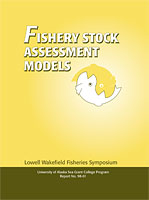
Evaluation of CPUE Estimates for the 1995 Crab Fisheries of the Bering Sea and Aleutian Islands Based on Observer Data
L.C. Byrne and D. Pengilly
- Price: $0.75 Sale: $0.00
 This is part of Fishery Stock Assessment Models
This is part of Fishery Stock Assessment Models| Format | Price | |
|---|---|---|
| PDF download [545 KB] Bypass cart and download |
Free | Add to Cart |
Description
Observers on board fishing vessels have gathered data from Bering Sea, Aleutian Islands, and western Gulf of Alaska crab fisheries since 1988. That data has provided estimates of catch per unit effort (CPUE) for both the directed catch and bycatch during the commercial fisheries. Because observers can sample only a small portion of the total effort from an observed boat and because observers are present only on the catcher-processor component of the commercial fleet in some fisheries, an evaluation of the precision and accuracy of fishery-wide CPUE estimates derived from observer pot samples is needed. We present such an evaluation for observed crab fisheries prosecuted in 1995. CPUE estimates and their standard errors were generated from data collected by observers from 27,627 pots sampled in 1995 fisheries and stratified by vessel-days. Estimates of mean CPUE for retained legal crabs were within 8% of CPUEs generated from confidential interviews in 10 of the 13 fisheries. Estimates of mean CPUE for retained legal crabs were within 8%of CPUEs generated from fish ticket delivery records in two of the five fisheries with less than 100% observer coverage. Differences larger than 8% between observer-based estimates and confidential interviews or fish ticket data were largely attributed to the small number of pots sampled by observers in those fisheries. Standard errors were in general very small, indicating the CPUE estimates were precise. Standard errors of CPUE estimates generated from bootstrap simulations were all equal to or less than the standard errors computed analytically. Bootstrapping also indicates that the sampling distributions for CPUE estimates of retained-legal crabs and commonly encountered bycatch are unimodal and symmetric.
Item details
- Item number: AK-SG-98-01c
- Year: 1998
- DOI: https://doi.org/10.4027/fsam.1998.03



